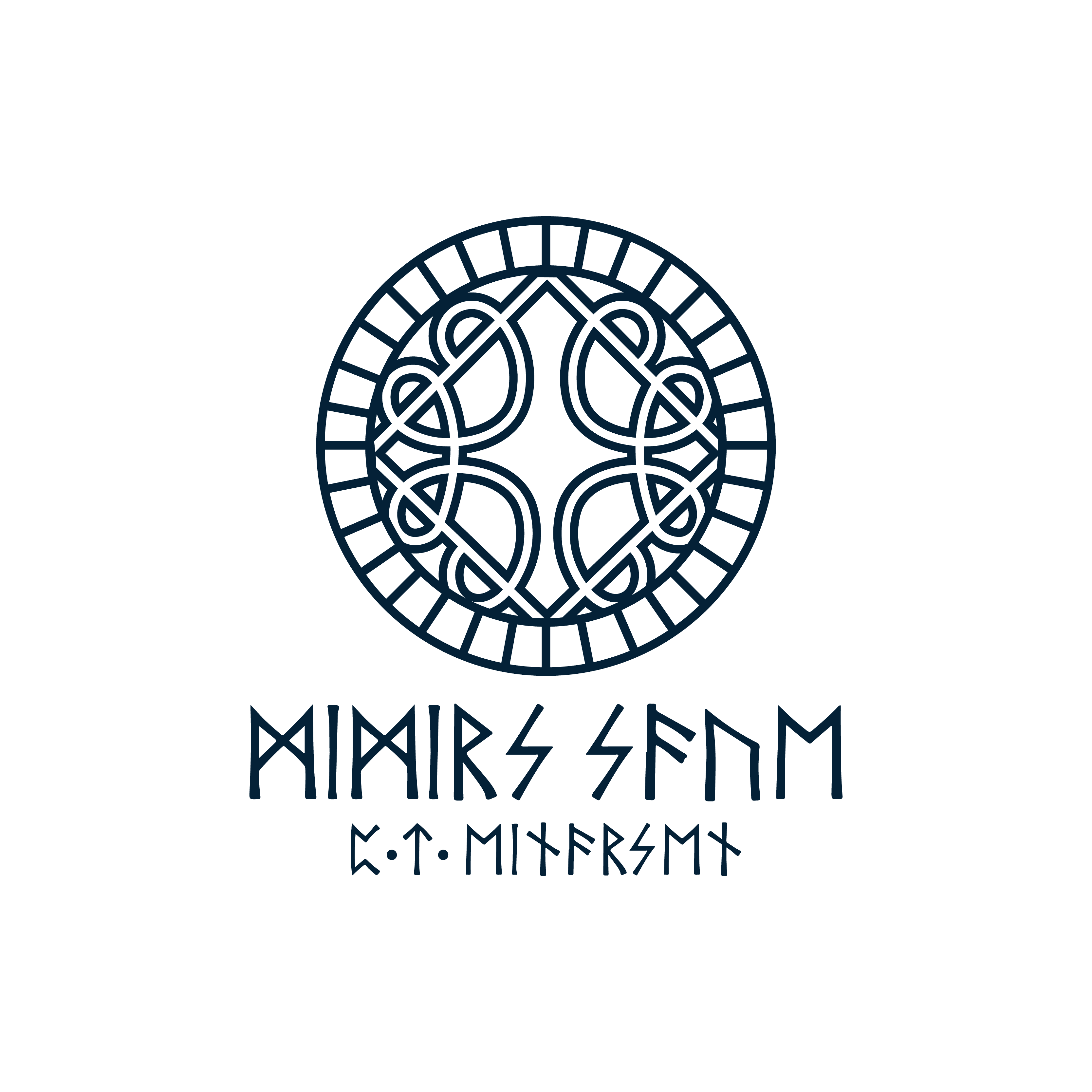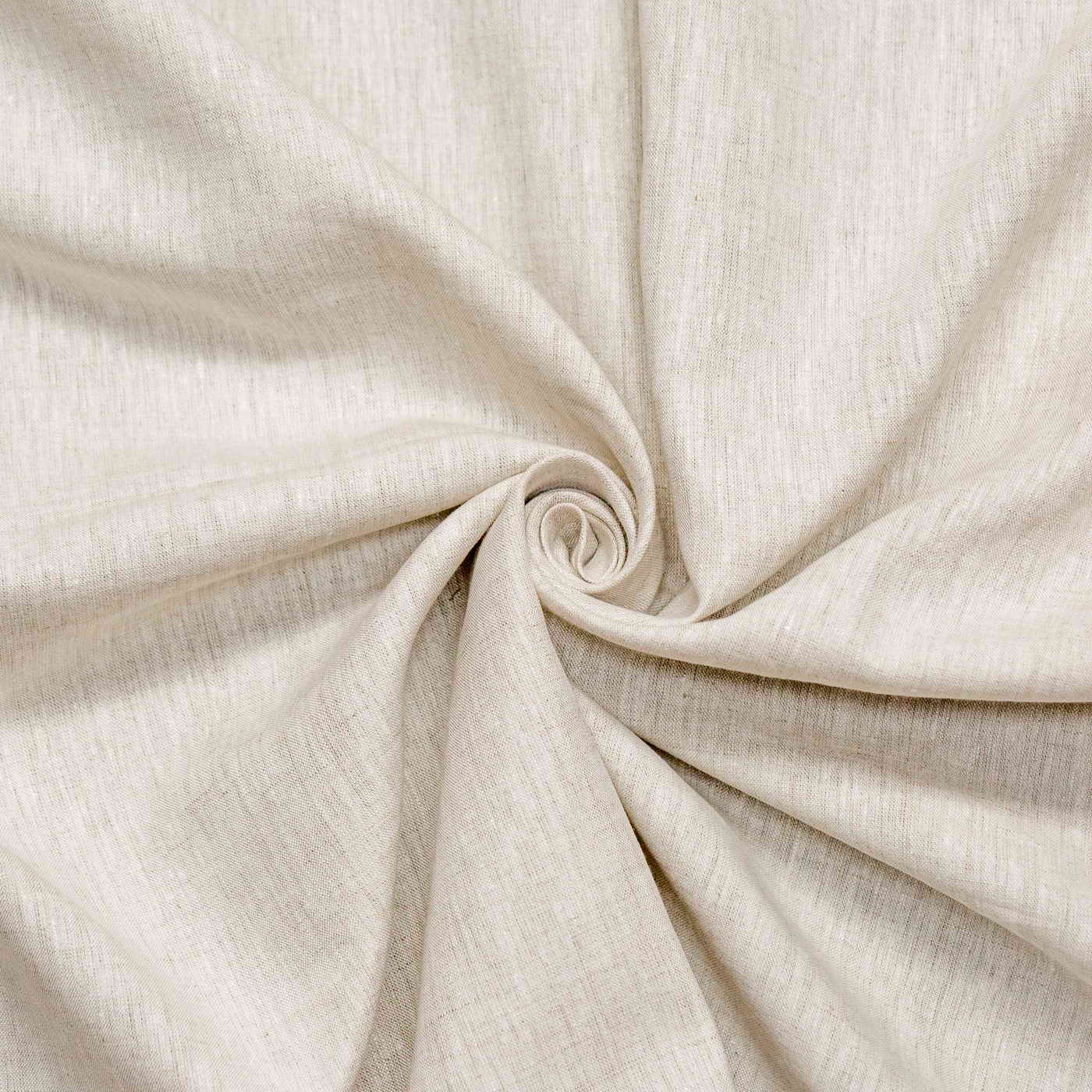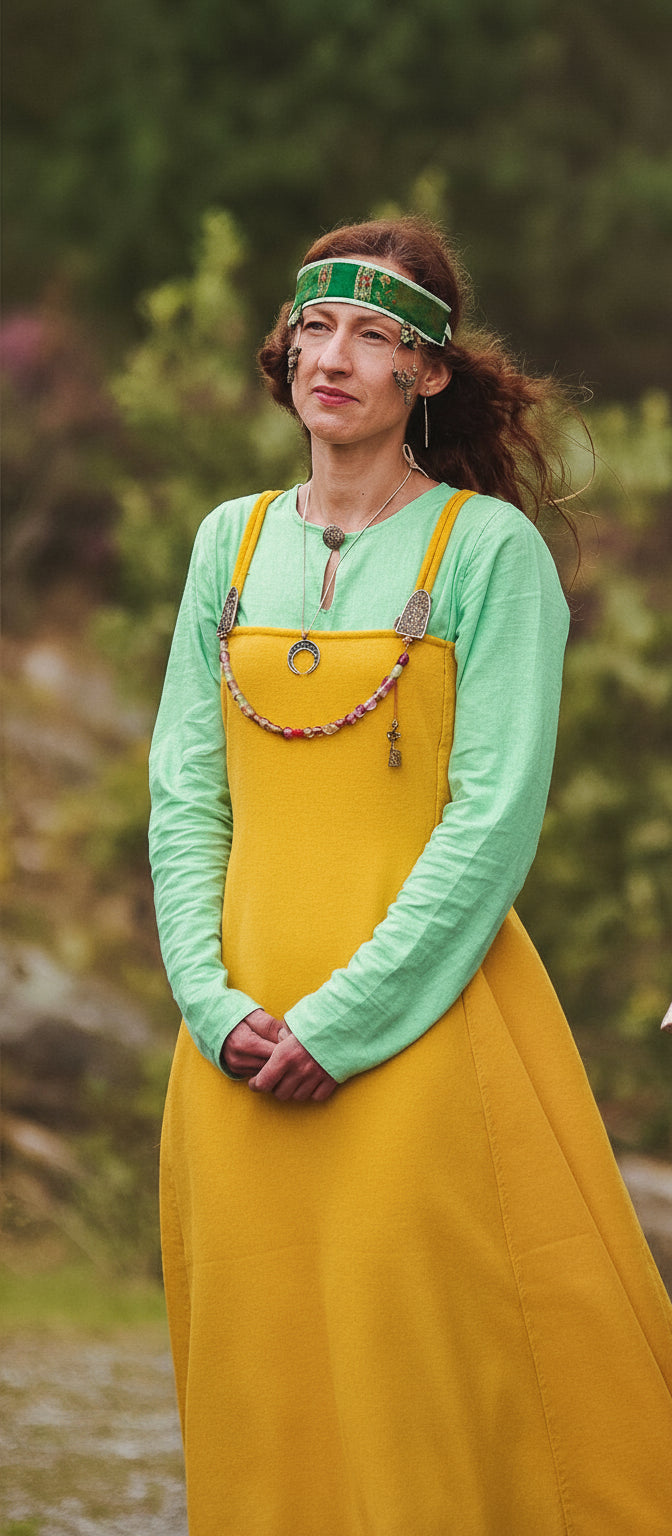
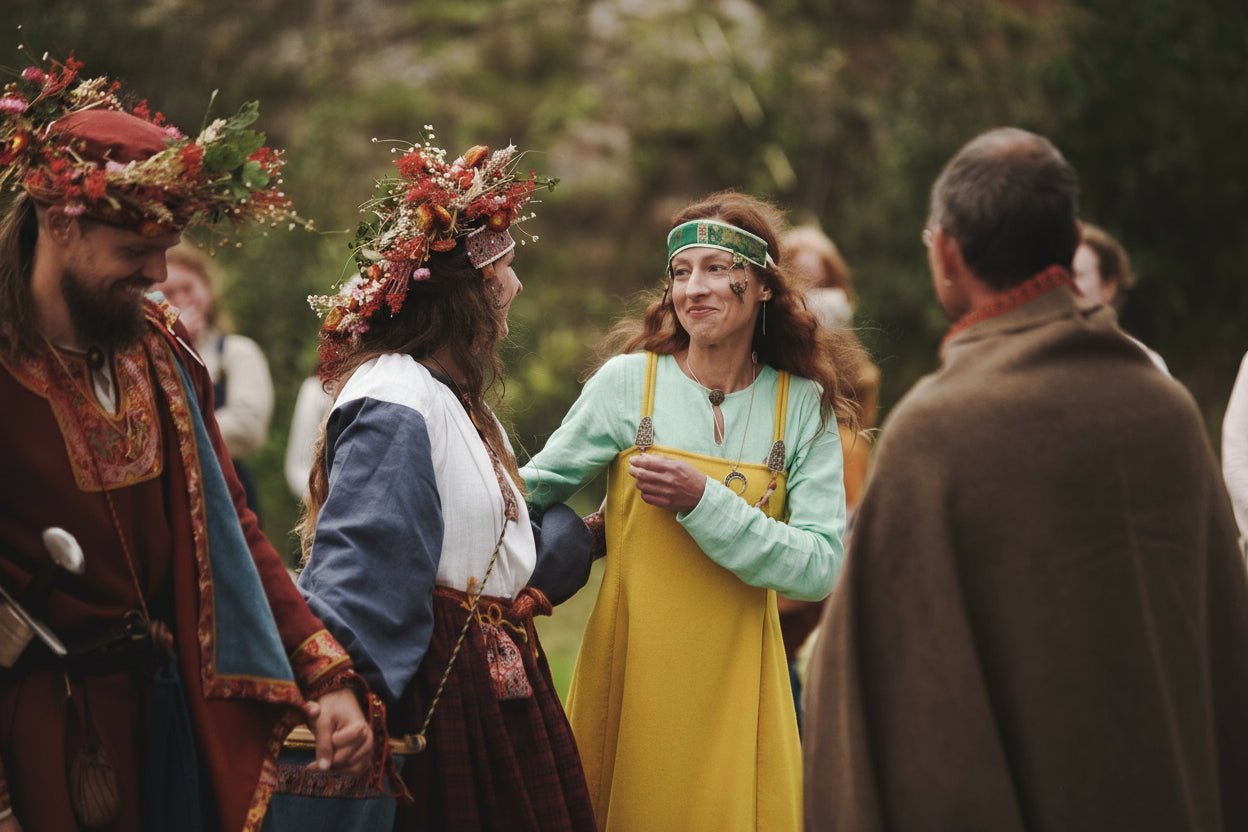
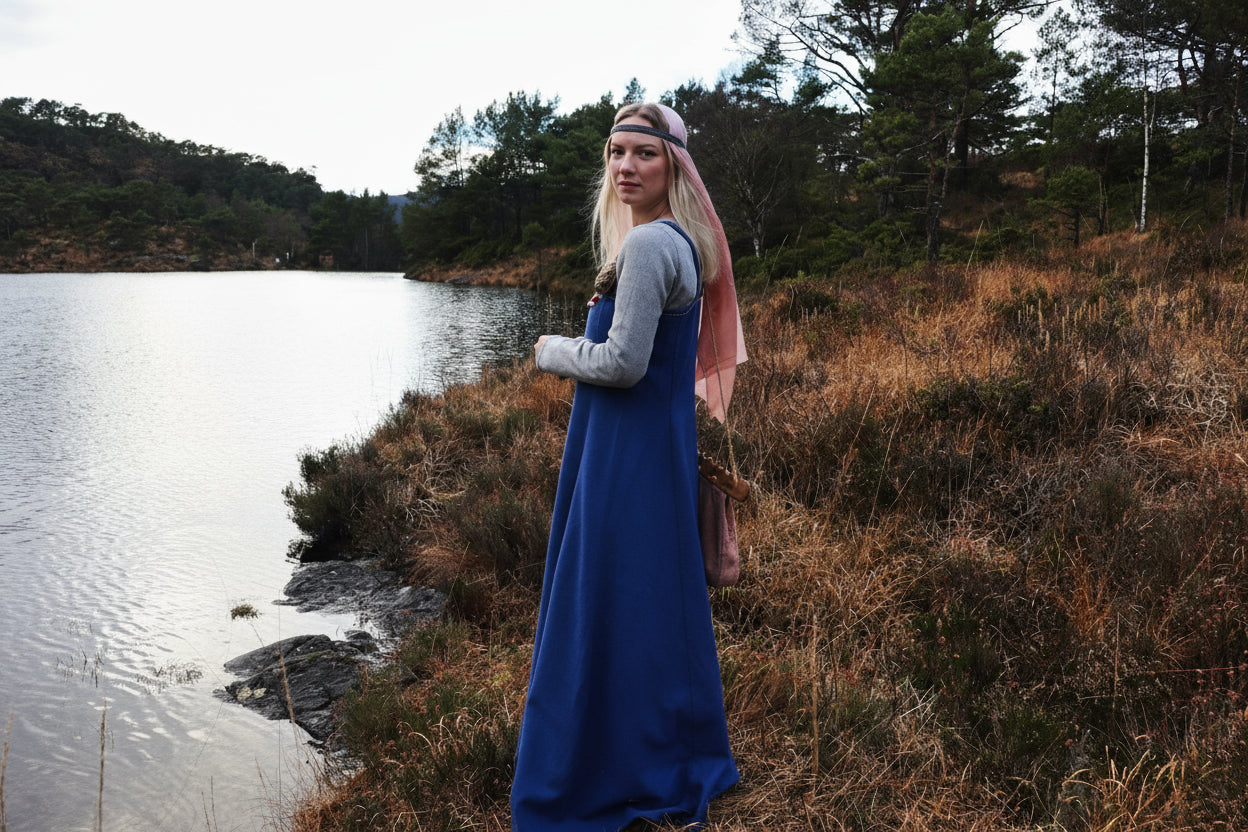
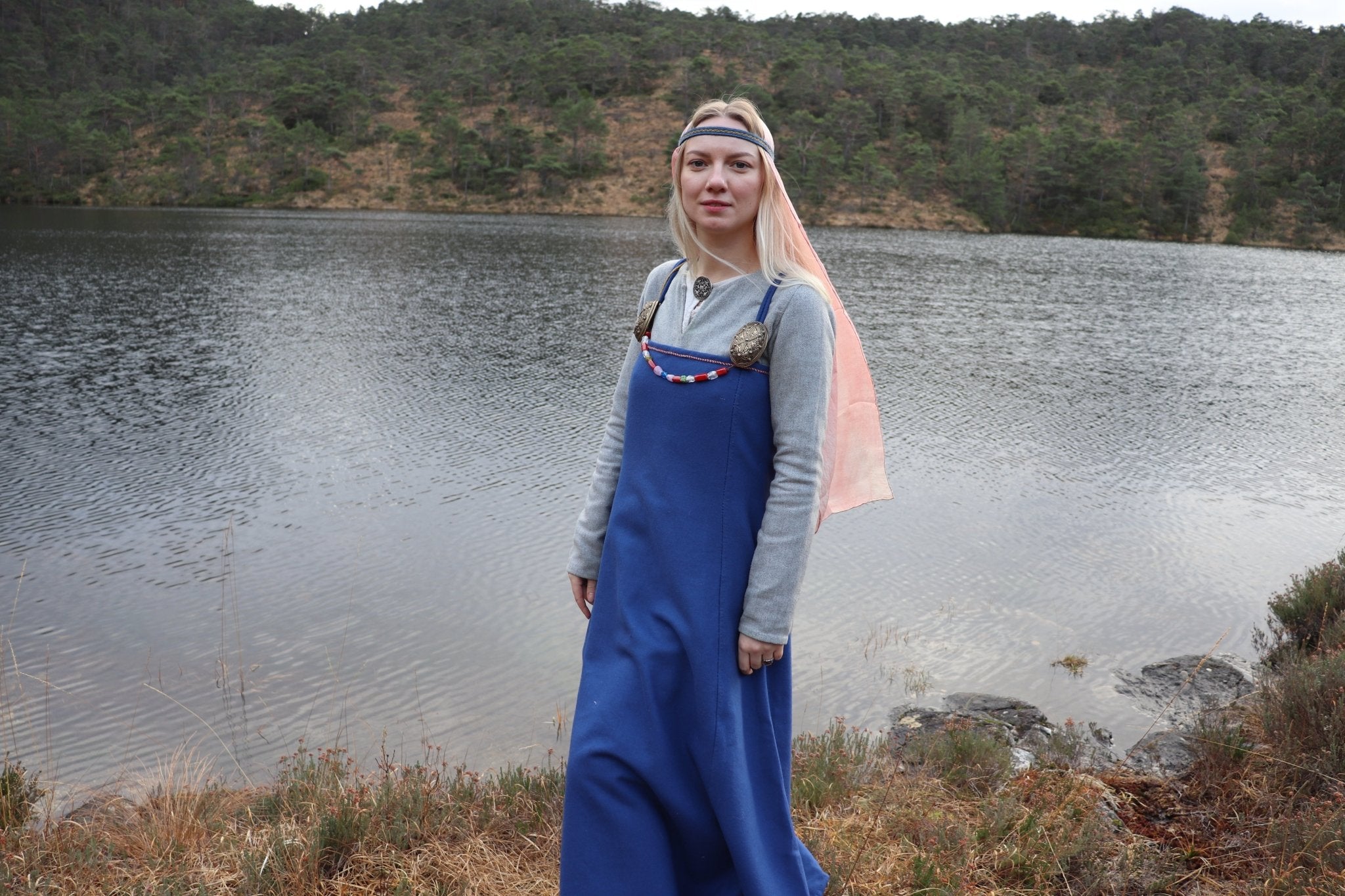
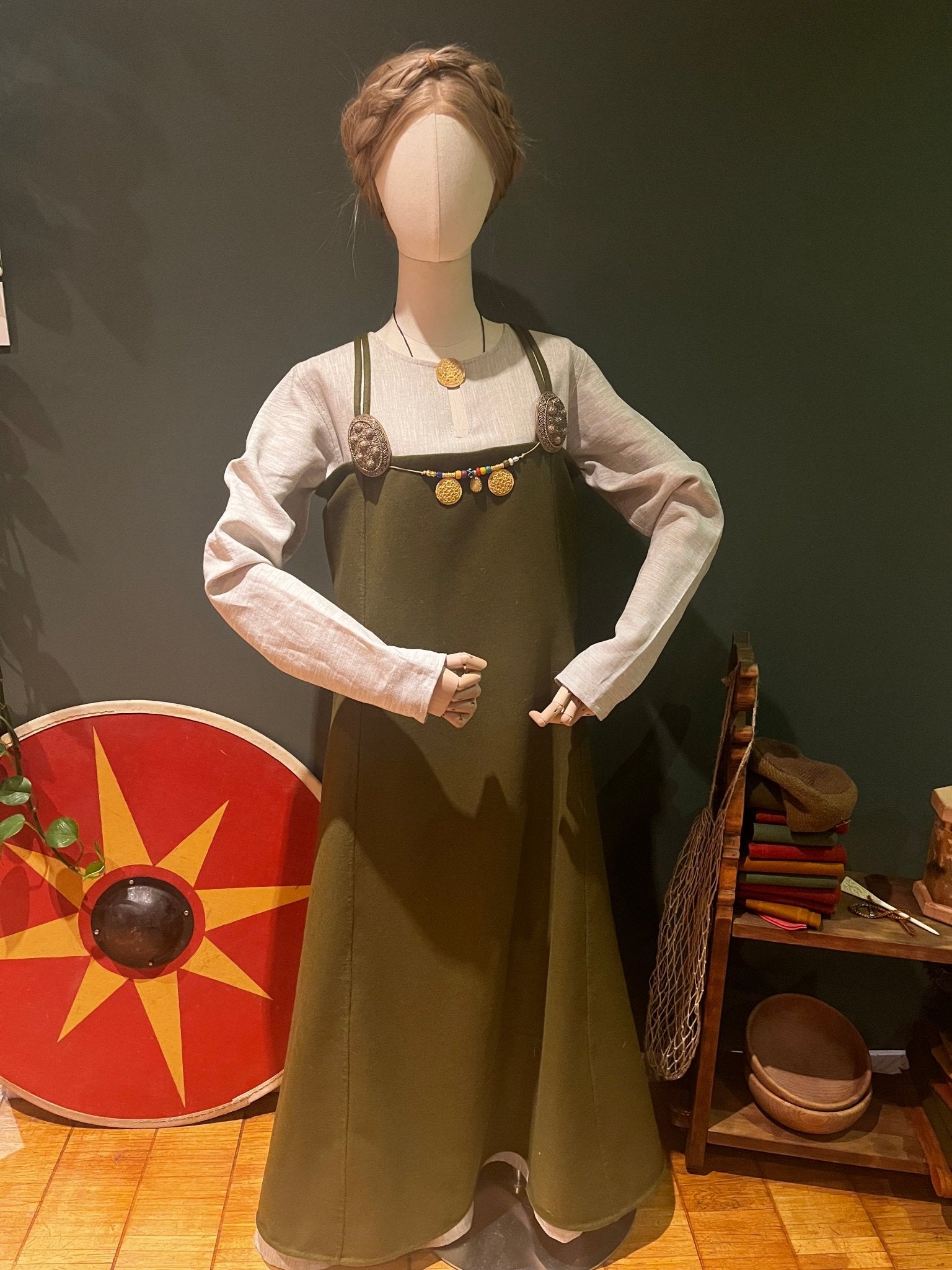
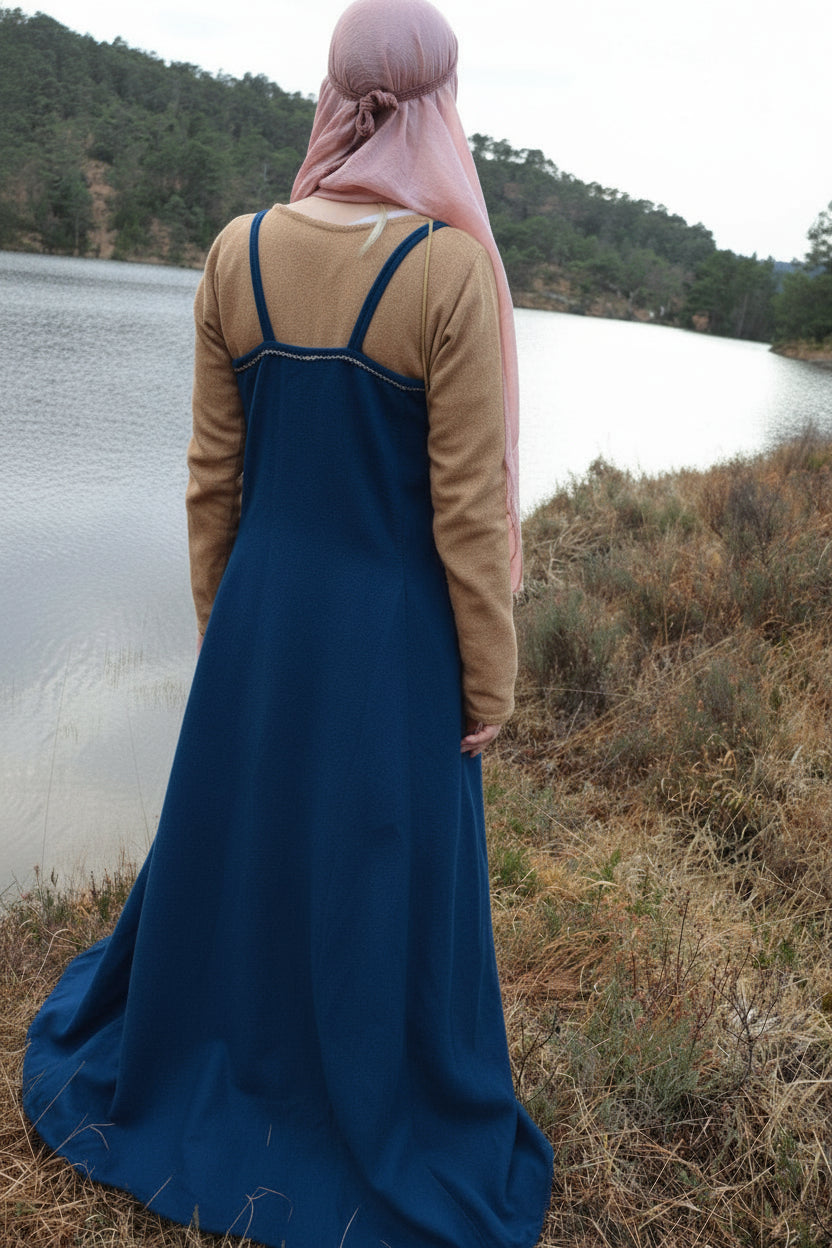
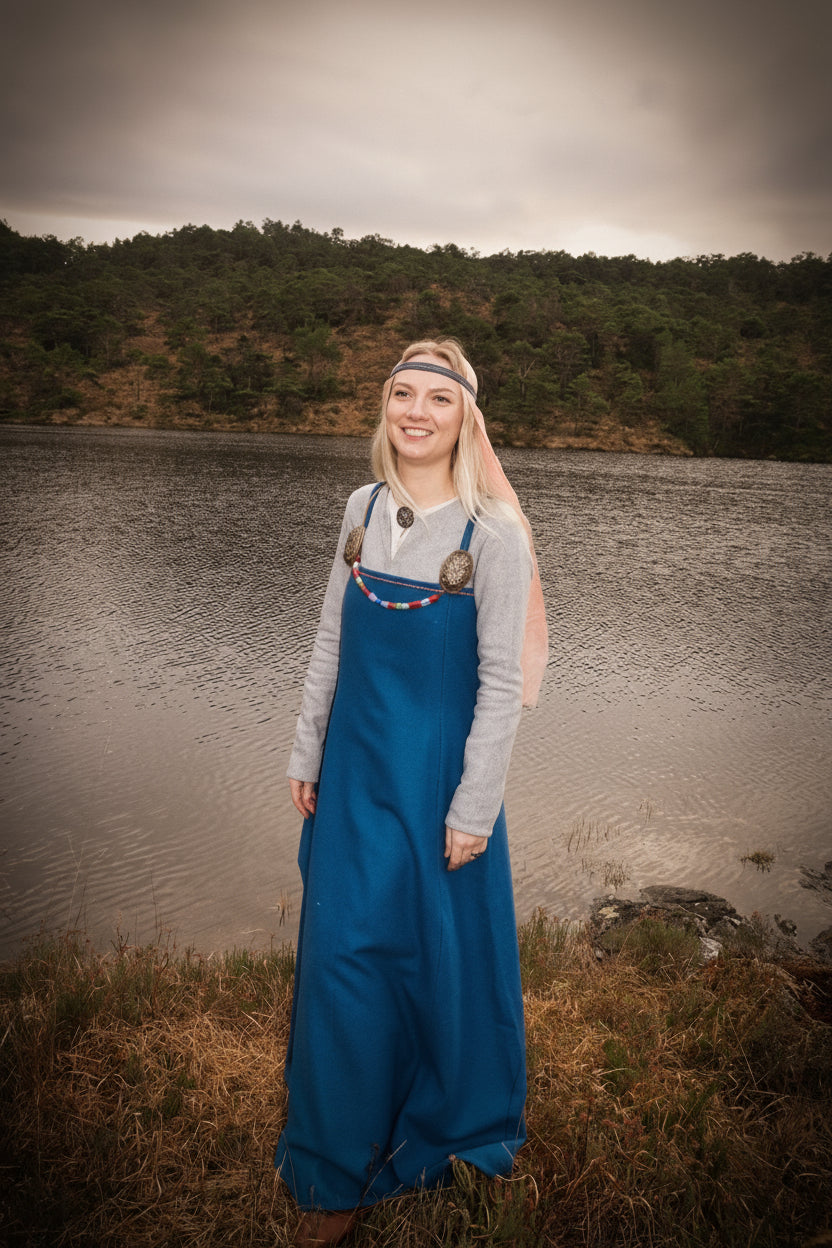
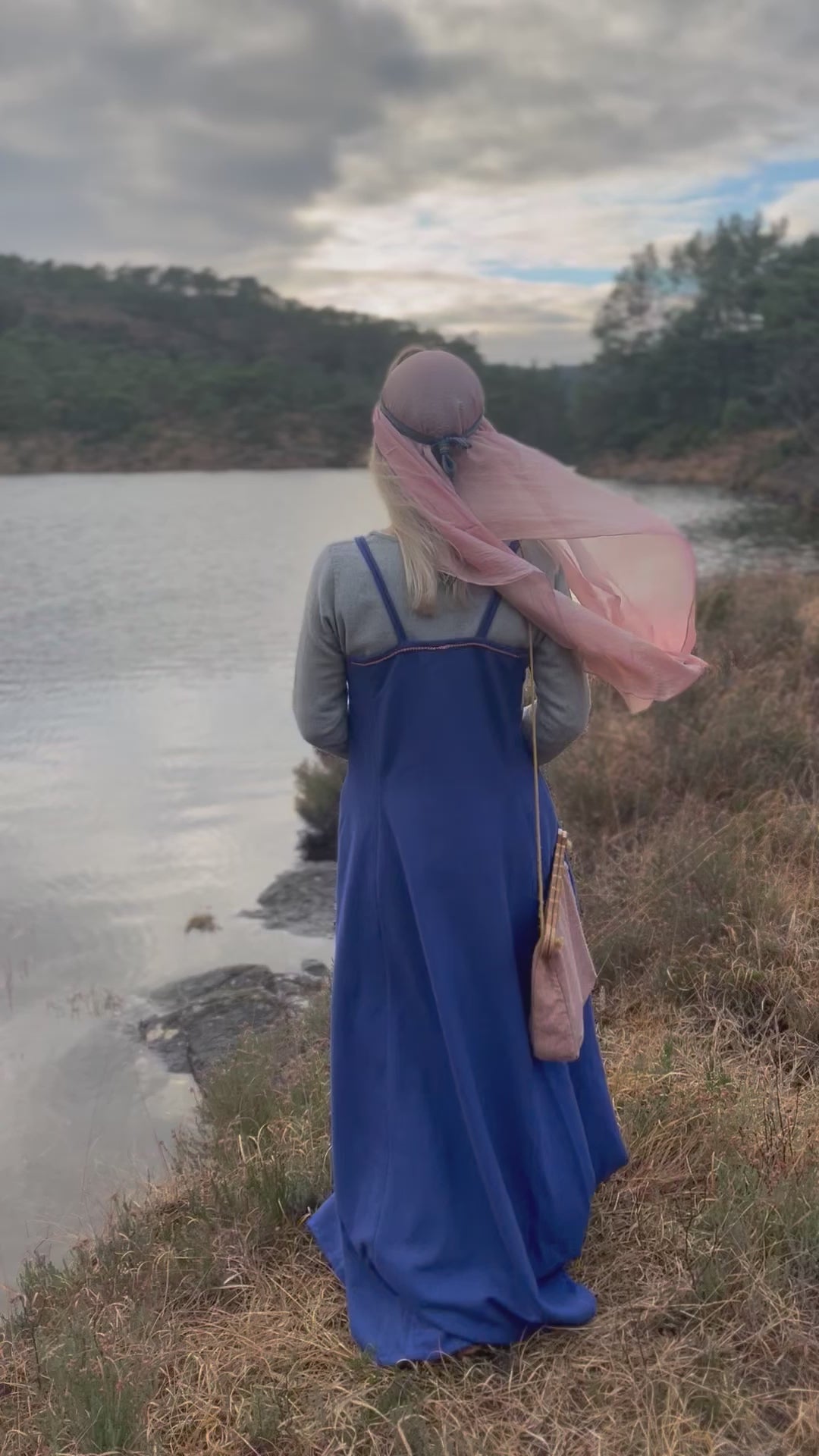
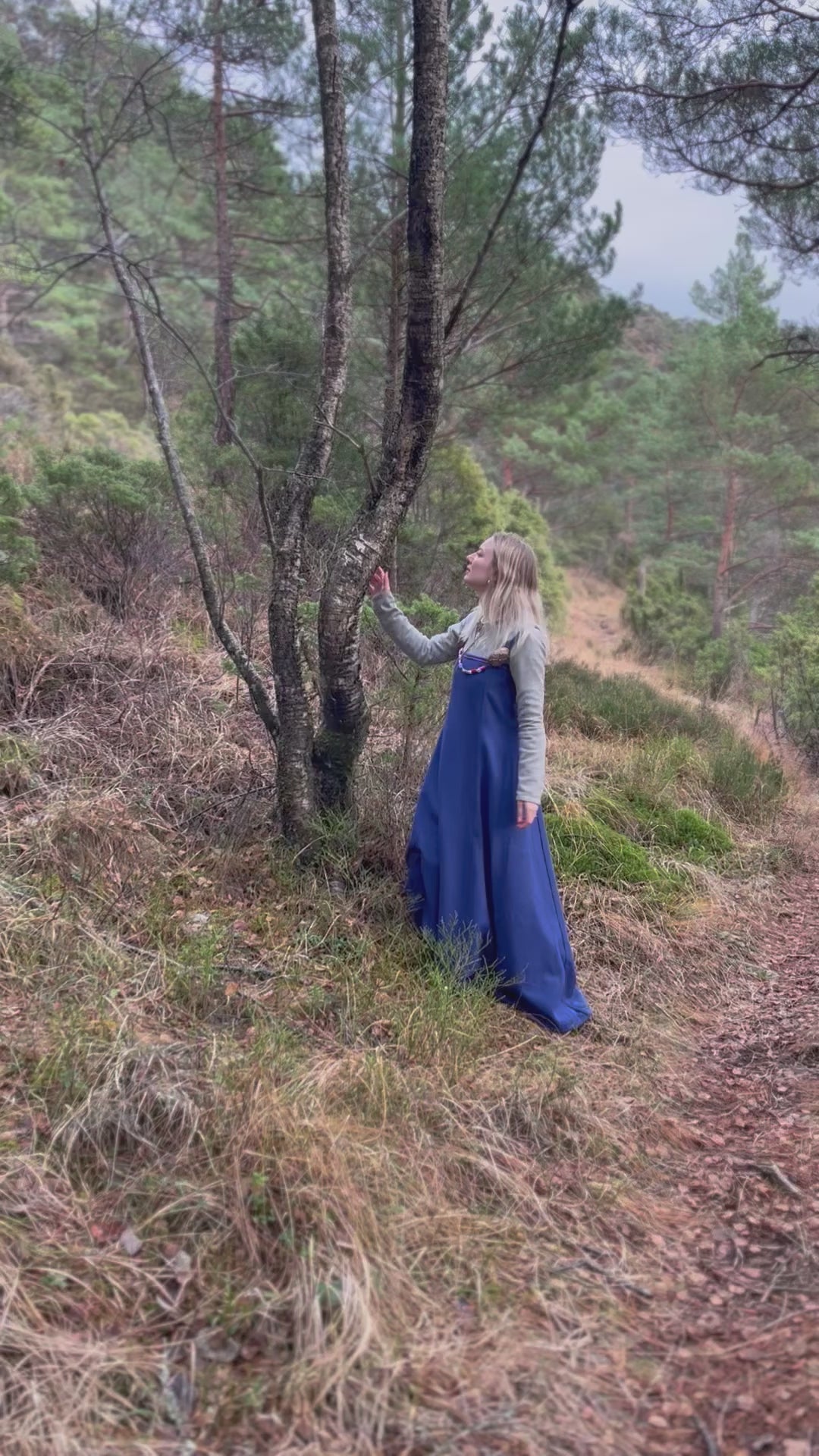
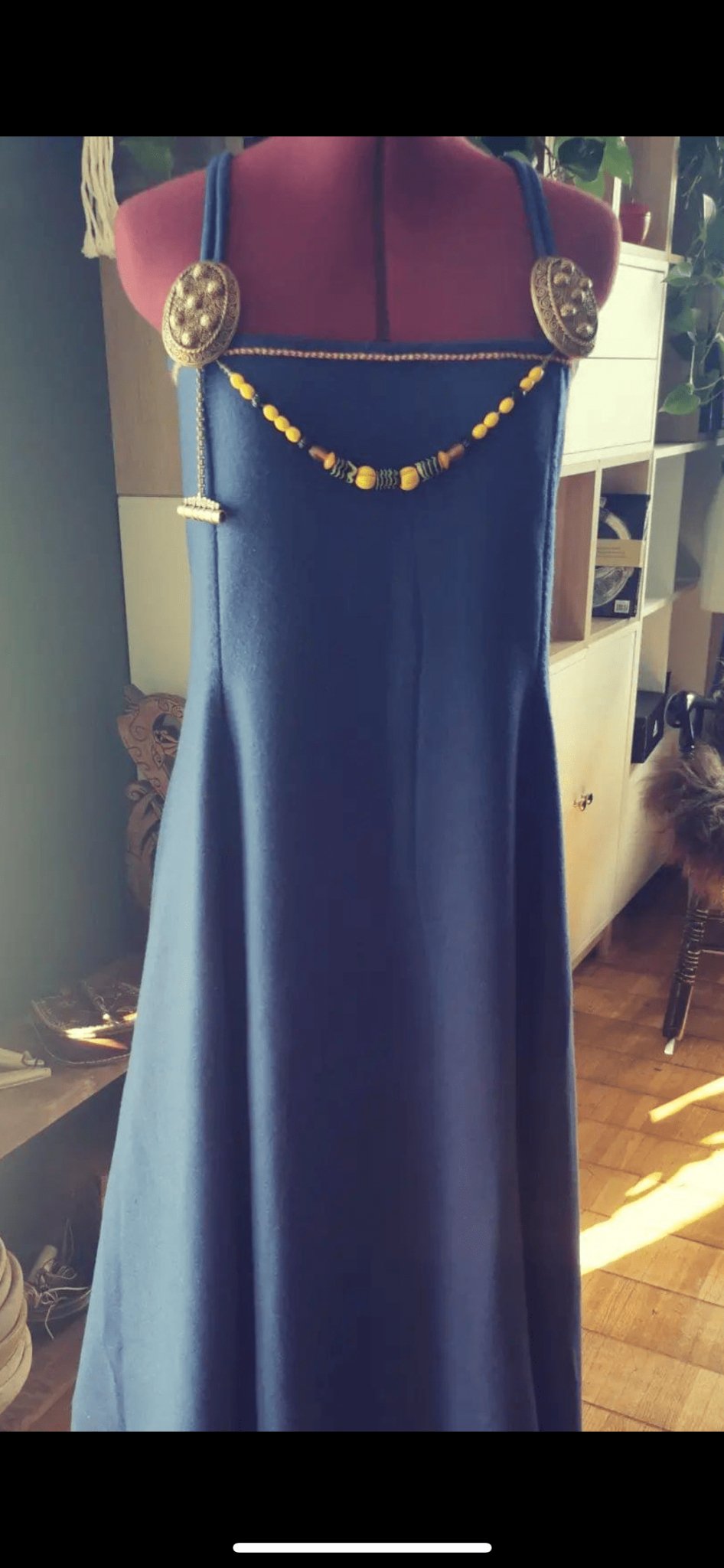
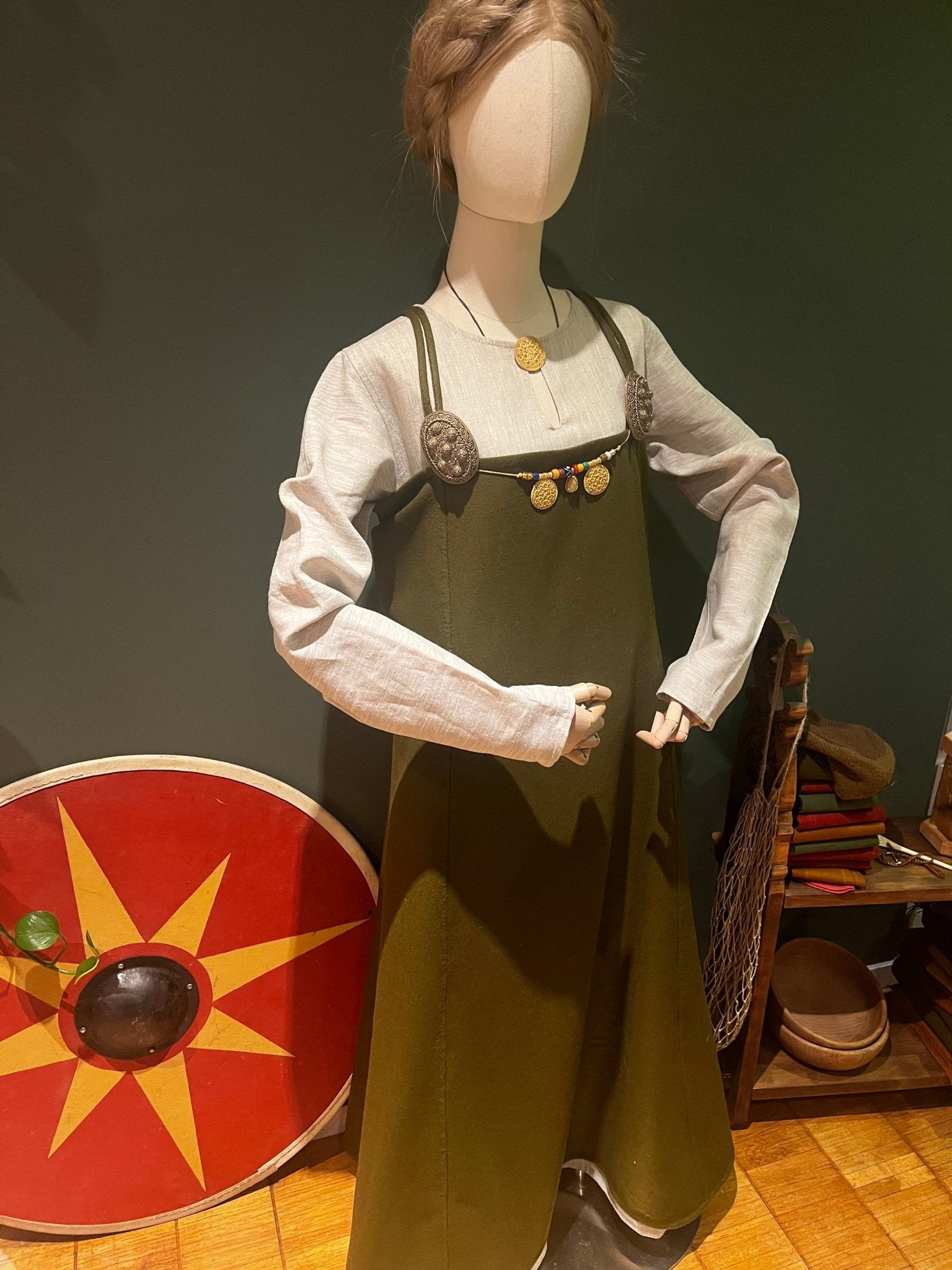
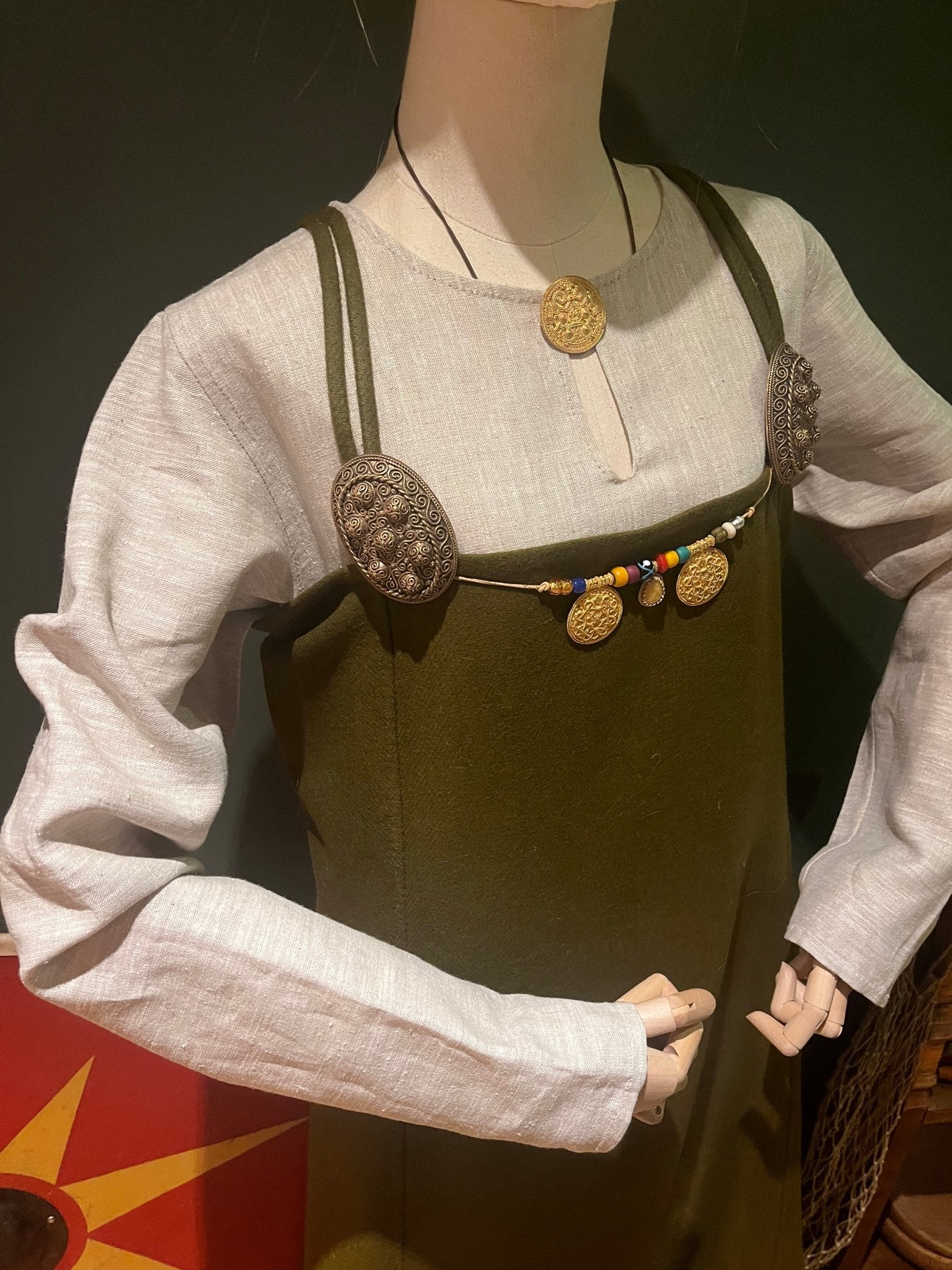
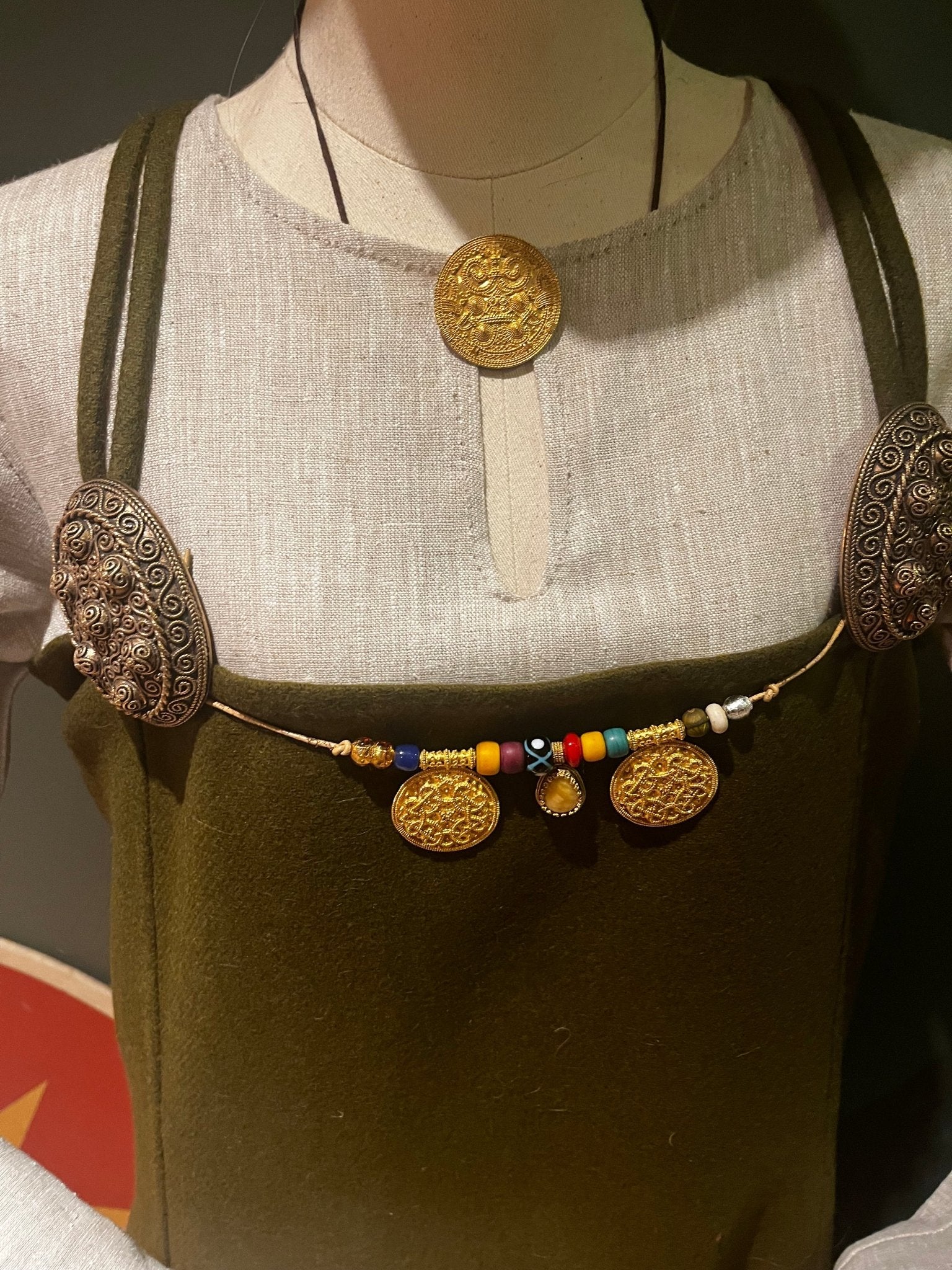
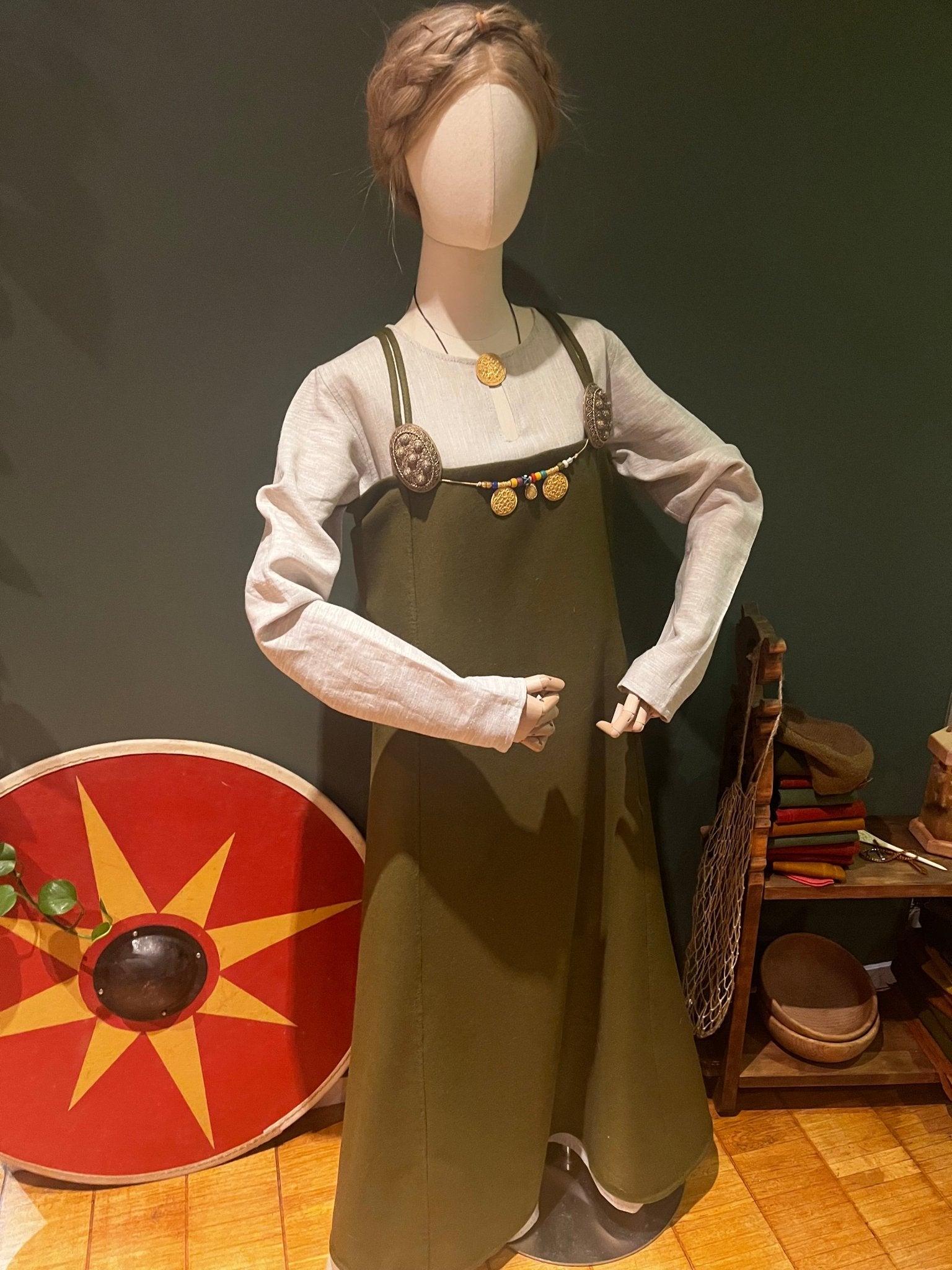
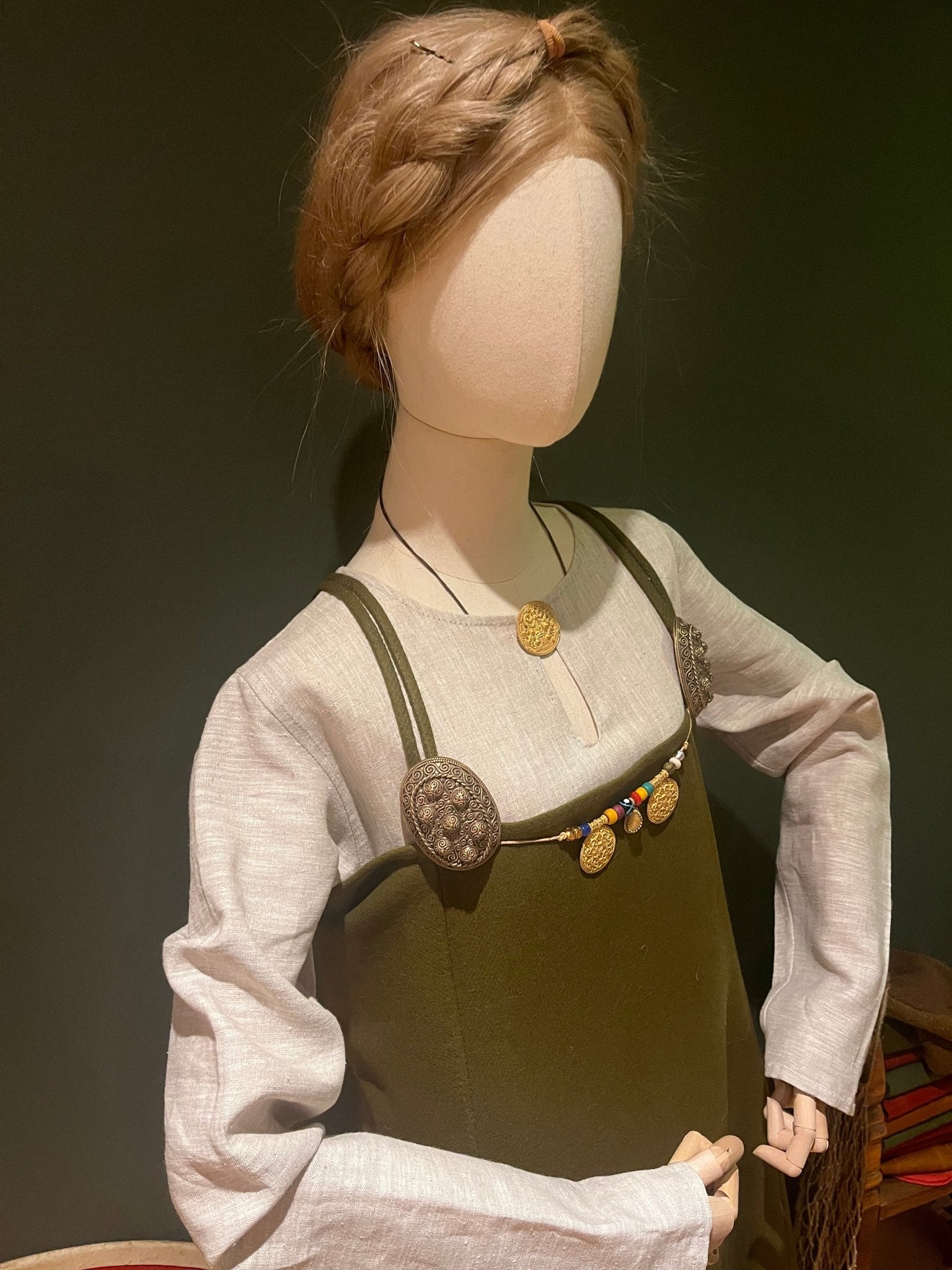

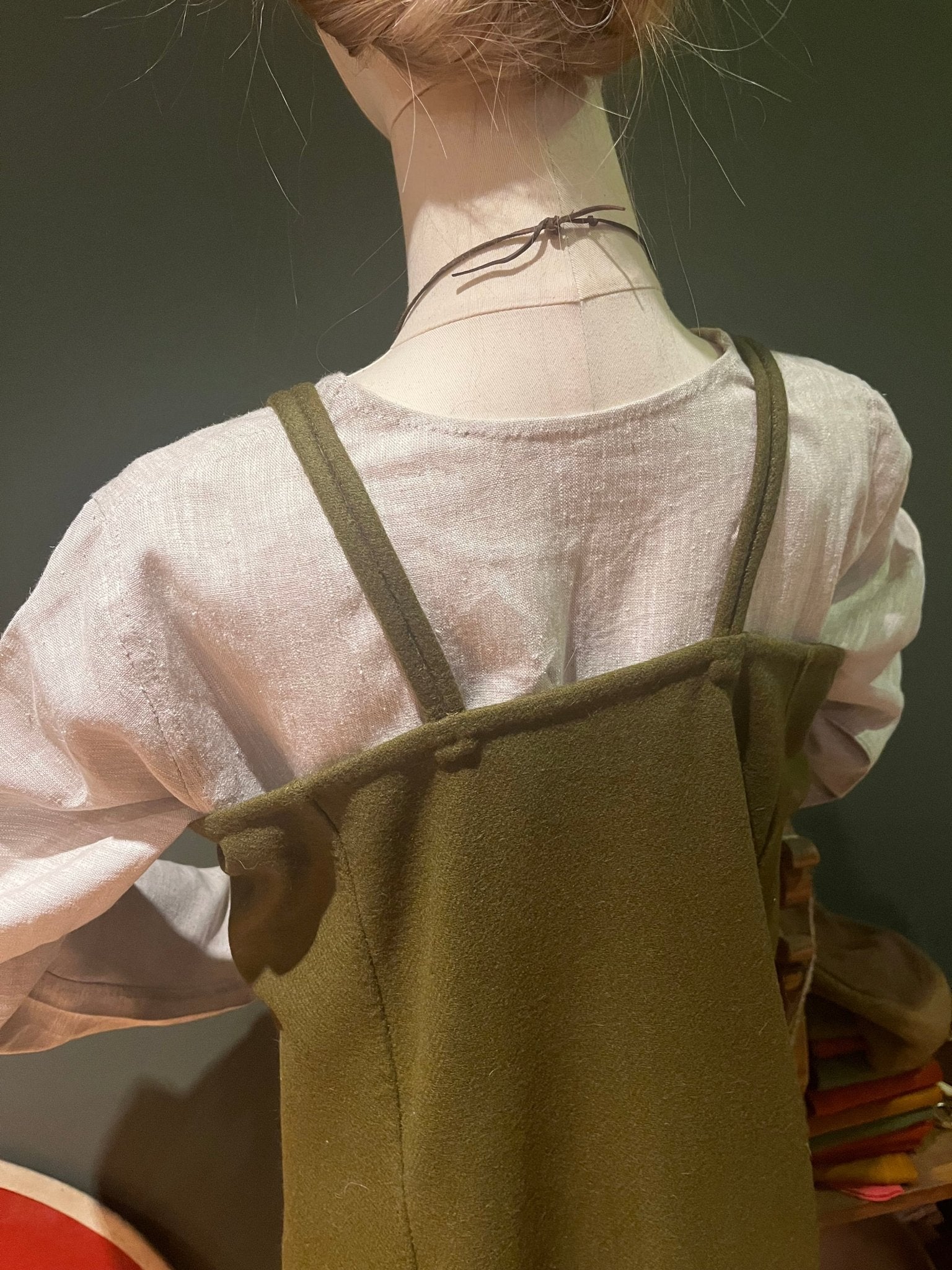
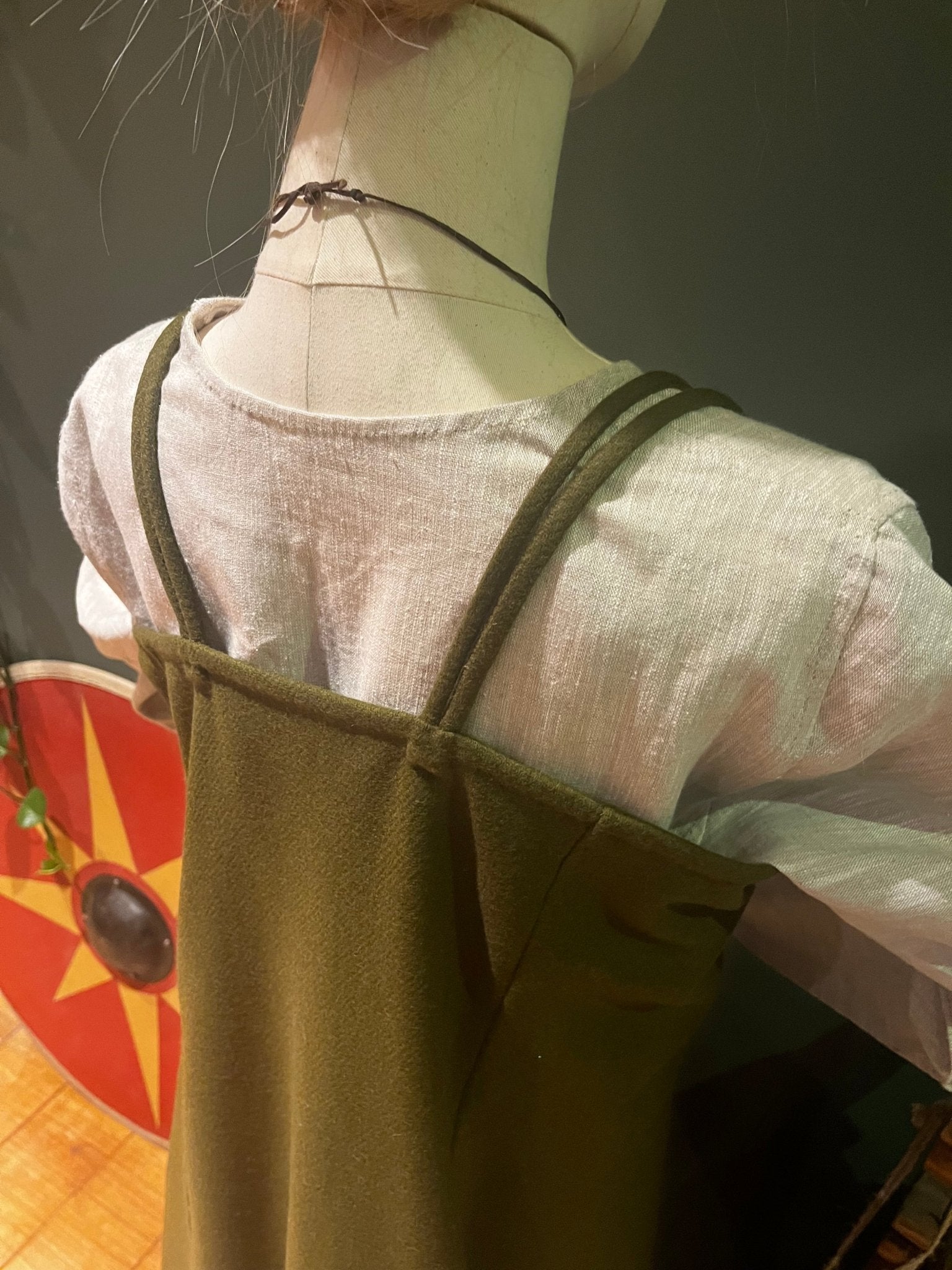
• ÅSA • Hand-Sewn Viking Age Four-Panel Apron Dress | Thin Tabby Wool | Based on Finds from Birka, Haithabu
A high-status layering piece for the well-equipped reenactor
The ÅSA Viking Age apron dress (hangerok) is one interpretation of several finds from Hedeby, Birka, and Pskov. As we don't have complete surviving garments from this period, this reconstruction is built from textile fragments, imprints preserved under oval brooches, and iconography.
This four-panel construction represents a different approach to understanding the fragments we have, offering an alternative to our Haithabu-based FREYDIS interpretation. The fitted chest and voluminous skirt create the characteristic apron dress silhouette found across multiple Viking Age sites.
Each dress is made to your individual measurements while following the proportions and silhouette known from historical research. Measuring instructions and details are below. You can provide your measurements during checkout or email them to us after purchase.
This Viking Age clothing piece is fully hand-sewn throughout in 100% wool (260g/m² tabby weave) from woolsome.shop. You can choose between linen or woolen straps—both options are documented in archaeological finds. Worn over your underdress and fastened with oval brooches at the top of the chest, right above the breast.
Processing time: Up to 120 days (may be faster depending on order queue)
➡️ Scroll down for detailed archaeological sources, construction techniques, materials, and customization options.
Personal note from one reenactor to another: This is a higher-status garment—the kind you'd wear to show status, not working the land. Before investing in an apron dress, make sure your foundational kit is solid and historically accurate. The apron dress is what you add when you're ready to show increased status and means.
• Historical reenactors seeking documented authenticity
• Museum demonstrations and educational displays
• Living history events and presentations
• Academic research and historical interpretation
• Educational institutions and heritage centers
• Hand-sewn using documented techniques
• Authentic seam placement
• Historical hem construction
At MIMIRS SAUM, every garment is crafted with care and attention to historical accuracy. All our pieces are made-to-measure based on your measurements, though occasionally we have ready-made garments available.
Ready-Made Products
- Clearly labeled as "Ready Made" in the product title
- Available in our storage and ready to ship
- Shipped within 5 business days if no adjustments are needed
- Processing time may extend slightly if adjustments are requested
Made-to-Measure Products
Every garment listed on our website is hand-sewn specifically for you based on your measurements.How it works:
- Choose your preferred color from available options
- Provide your measurements at checkout in the notes section, or email them to us at contact@mimirs-saum.com after purchase
- Once payment and measurements are received, your order enters our production queue
- Processing time varies based on season and order volume, with a maximum of 120 days during peak periods
Need it urgently? Contact us at contact@mimirs-saum.com and we'll do our best to expedite your order.
Measurement guidance: Not sure how to measure? We'll provide detailed instructions after your purchase, or contact us anytime for assistance.
Special requests: Need a non-standard color, plant-dyed fabric, or unique construction? Contact us at contact@mimirs-saum.com to discuss your vision. A 50% advance payment is required for special orders to cover material costs, with the remaining balance due upon completion.
Customize your piece of clothing
A Piece of Living History
What the Archaeological Record Shows
Apron dress fragments have been found across the Viking Age world—Birka, Haithabu, York, Dublin, Pskov—dating from the 8th to 11th centuries. Each site contributes specific evidence: construction methods from one grave, loop placement from another, finishing techniques from a third.
No single grave gives us a complete garment. What we have are fragments—some with construction details, others with strap placement, still others with stitching patterns. ÅSA is a composite reconstruction, combining the strongest evidence from multiple sites to create an apron dress that reflects what Viking Age women actually wore.
Birka (Sweden, 793-972 CE) has over 100 graves with apron dress fragments—loop placement, color evidence, finishing details. Haithabu (Germany, 8th-11th century) provides construction evidence, seam specifications, stitching patterns. York and Dublin add regional variations. Pskov (Russia, mid-10th/early 11th century) shows wide front panels and pleated construction.

Documented Techniques from 8th-11th Century Textile Finds
VIKING AGE CONSTRUCTION METHODS ✨ Archaeological Evidence in Every Stitch
Body Construction: Haithabu Innovation
Archaeological evidence from Haithabu (8th-11th century) forms the foundation of our four-panel design, with particular focus on the harbor settlement's extensive textile corpus. The brown-dyed wool fragments from Haithabu, with their preserved stitch holes and construction evidence, provide crucial documentation for Viking Age dress making.
Historical Construction Details:
🧵 Primary Evidence: Haithabu Harbor Finds
• Construction Documentation:
- Fragment H14A (30cm x 16-23cm x 0.1cm): • Panel construction evidence • Stitch hole preservation • Material thickness specifications
- Fragments 64 & 65: • Backstitch spacing: 4-6mm • Running stitch: 3-5mm • Seam allowances: 8-10mm
- Fragments 48 & 49: • Whipstitch: 2-3mm • Edge finishing methods • Reinforcement techniques
- Harbor finds 91 & 92: • Panel joining evidence • Thread diameter specifications
- Fragments 101 & 102: • Hem construction: 12-15mm depth • Edge treatment methods
📏 Supporting Evidence
• Birka (793-972 CE):
- Complementary construction methods
- Supporting panel evidence
- Comparable seam techniques
✨ Construction Standards
Each ÅSA reflects verified Haithabu evidence:
• Main seams following fragments 64 & 65
• Edge treatments based on fragments 48 & 49
• Four-panel assembly incorporating H14A specifications
• Hem construction following finds 101 & 102
• All techniques cross-referenced with Birka finds
LOOP CONSTRUCTION
✨ Archaeological Evidence
Primary Sources: Haithabu Finds
• Grave Finds 159/1960 & 182-185/1960:
- Loop placement documentation
- Material evidence: both linen and wool
- Attachment methods preserved
- Spacing measurements
• Harbor Settlement Evidence:
- Fragment 82 A-D: Loop construction
- Preserved stitching patterns
- Thread diameter specifications
- Attachment techniques
Supporting Evidence:
• Birka Graves (793-972 CE):
- Complementary loop placement
- Material usage variations
- Regional adaptations



Premium Wool - Matching Textile Finds from Viking Age Settlements
Viking Age Wool: Woven to Archaeological Standards
Our offer includes four wool fabrics—each one documented in Viking Age archaeological finds. I've chosen historically accurate colors from Woolsome's collection that match what we see in the evidence. All are 100% highest quality wool.
Here are your options:
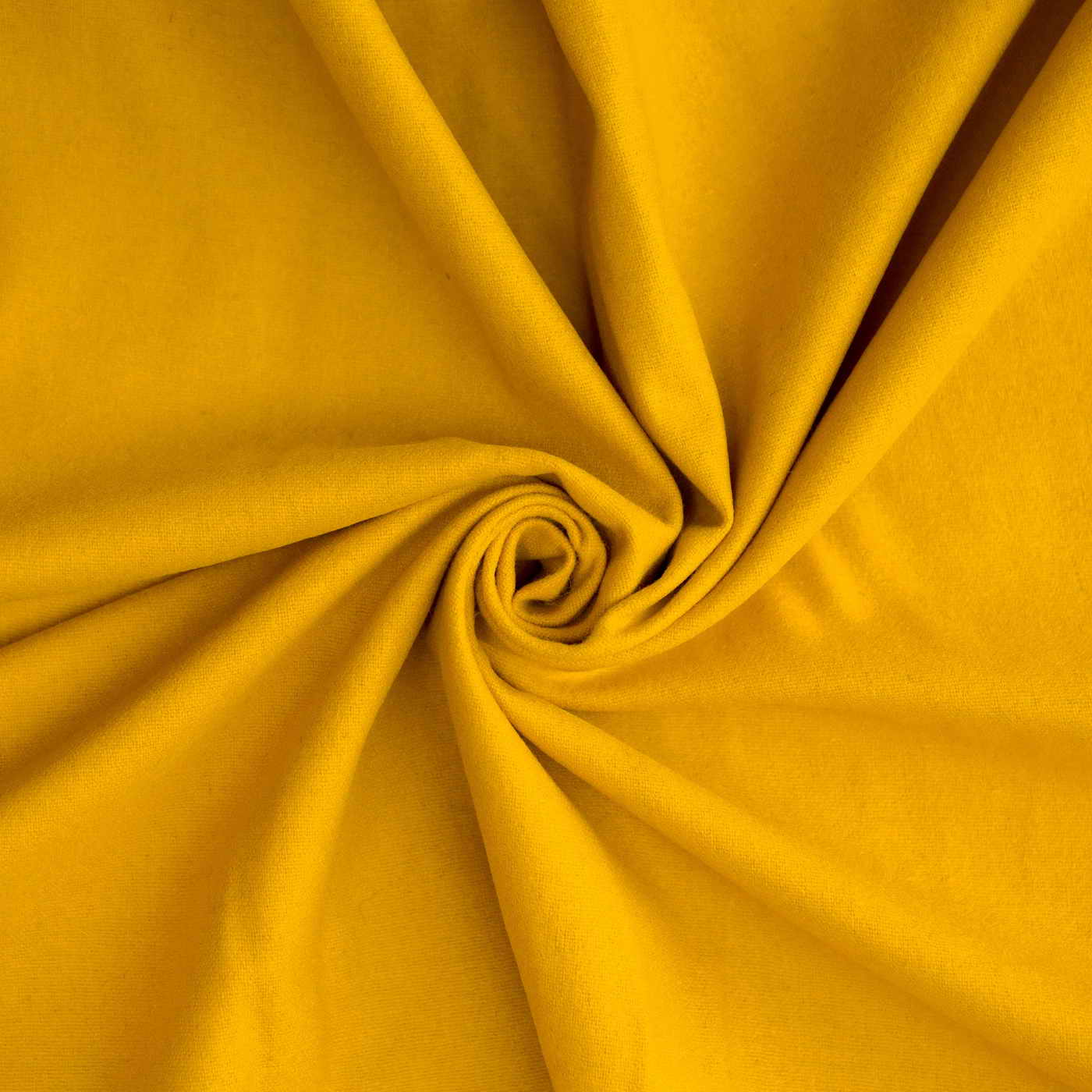
Thin Tabby 260 g/m²
Plain weave, the lightest option. Documented at Køstrup. Good for dancing, fighting, or warmer months. Breathable, comfortable, historically accurate.
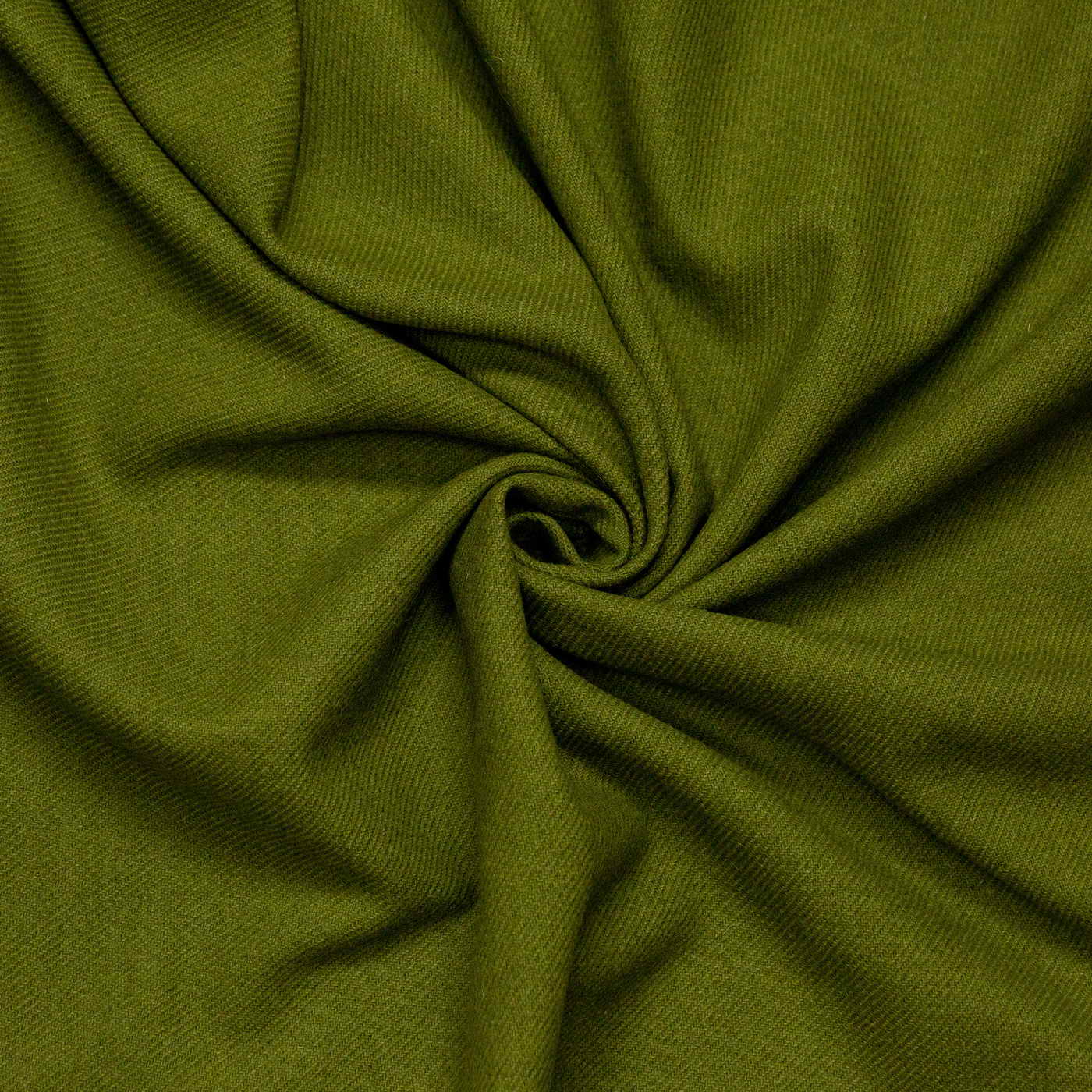
Thin Twill 290 g/m²
2/2 twill, lightweight. Good for layering, summer events, or if you prefer something that breathes. Matches the lighter fragments from Birka and Haithabu. Moves well, drapes well, works spring through autumn.
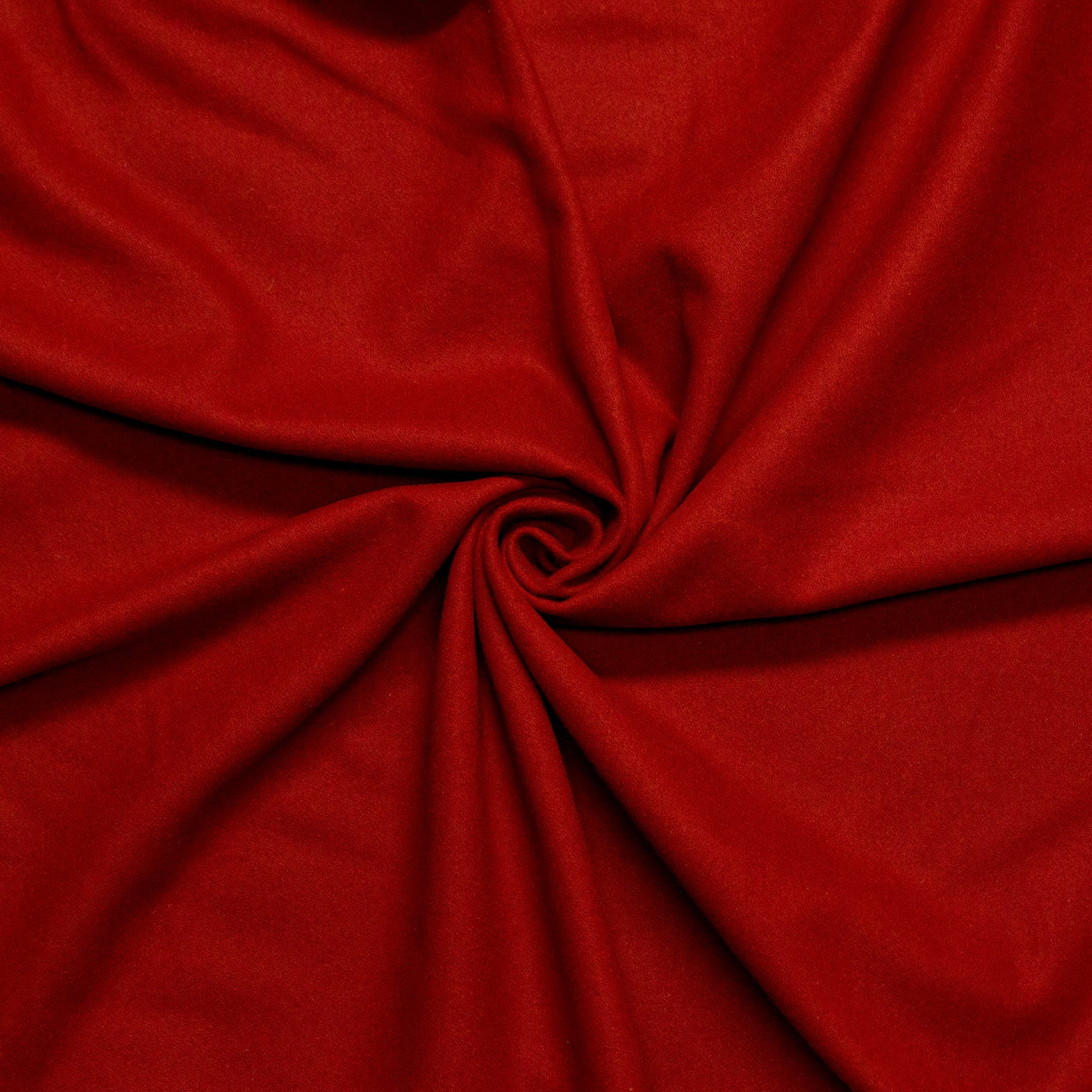
Broken Twill 370 g/m²
Medium weight, fulled for warmth and durability. Dense, structured, holds up to Scandinavian winters and long event seasons. If you need something that lasts and keeps you warm, this is the one.
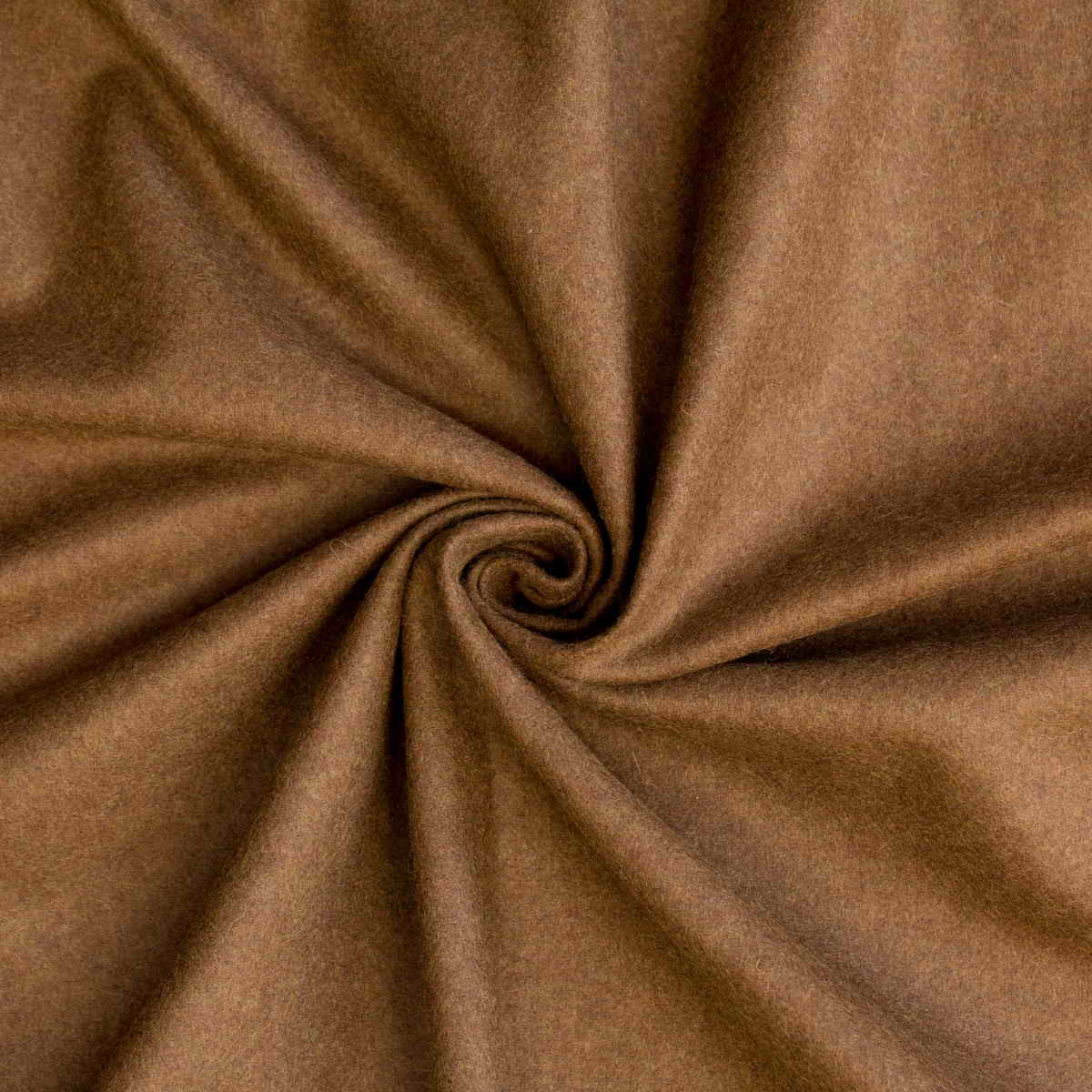
Fulled Twill 370 g/m²
Medium weight, fulled for warmth and durability. Dense, structured, holds up to Scandinavian winters and long event seasons. If you need something that lasts and keeps you warm, this is the one.
Our Commitment
Each garment is created with the same attention to detail found in Viking Age textiles. Whether you're demonstrating historical techniques at a museum, participating in reenactment events, or simply appreciate historically accurate clothing, our pieces offer both authenticity and functionality.
⏱️ Processing Time: Up to 120 Days
How Your Garment Is Made
Each piece is individually hand-sewn using Viking Age techniques and archaeological evidence. Here's what goes into creating your historically accurate clothing:
🧵 The Creation Process
Our process honors the traditional methods of Viking Age craftspeople:
Mindful Material Preparation
We begin by carefully preparing your chosen fabric—washing, drying, and pressing premium linens from Woolsome's LCP collection or fine wools from the WTV/WKT collections. This essential step ensures proper fabric behavior and lasting quality.
Historical Pattern Making
Each pattern is thoughtfully drafted based on your measurements and archaeological evidence from sites like Birka and Haithabu, creating garments that are both authentic and perfectly fitted to you.
Precise Cutting
Using traditional techniques, we carefully cut each piece to ensure historical accuracy in shape and grain alignment—crucial for proper drape and authentic silhouette.
Hand-Stitching Legacy
Every single stitch is placed by hand, using historically documented techniques like running stitch, backstitch, and whipstitch that create strong, durable seams. No sewing machines—ever.
Quality Assurance
Each piece undergoes careful inspection and thoughtful preparation for its journey to you, maintaining our strict standards of historical accuracy and craftsmanship.
📋 Important Notes From Your Historical Seamstress
- Your garment's creation begins at order confirmation
- Each piece is crafted individually in the order received
- During festival seasons and markets, the timeline may extend beyond 120 days
- I create each piece in my free time outside my day job
- Quality and historical accuracy are always our primary focus
- Shipping time is additional to the crafting period
- Each order receives individual attention and care
- Your patience ensures historical perfection
Questions during the process? Reach out to contact@mimirs-saum.com—I'll respond as soon as I'm able.
✨ Our Commitment to Craft
At MIMIRS SAUM, we believe true Viking Age craftsmanship cannot be rushed or mechanized. Every garment we create is entirely hand-sewn, stitch by stitch, using the same techniques documented in archaeological findings from Birka, Haithabu, and other Viking Age settlements.
Our dedication to historical accuracy means we work exclusively with premium natural materials—linens from Woolsome's carefully curated collections, fine wools, and authentic silk brocades. Each fabric is chosen not just for its quality, but for its historical accuracy in weight, weave, and characteristics.
When we say "hand-sewn," we mean exactly that. Every single stitch is placed by hand using historically accurate techniques. No sewing machines are ever used in our workshop. This isn't just about creating clothing—it's about preserving and practicing the authentic crafting methods of the Viking Age.Your patience and support make this level of craftsmanship possible. Thank you for valuing historical accuracy and traditional techniques.
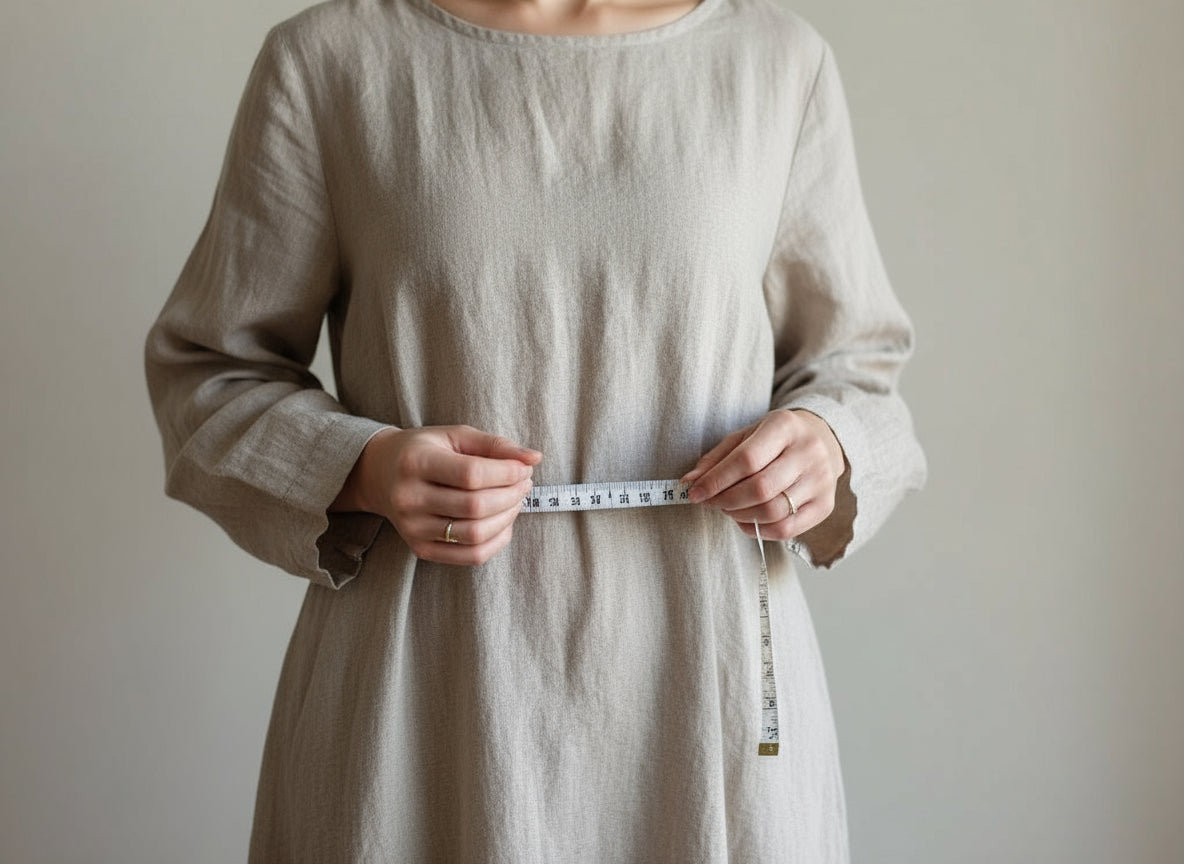
A Guide to Historical Garment Measurements Based on Viking Age Findings
HOW TO MEASURE YOURSELF ✨
Essential Measurements Guide
• Chest/Bust
Stand straight, arms relaxed. Measure around the fullest part, keeping tape parallel to ground.
• Shoulder Width
Measure from outer edge to outer edge, following natural curve.
• Arm Length
With slightly bent arm, measure from shoulder point to wrist bone.
• Length
For tunics: Measure from shoulder top to desired length.
Historical Accuracy Note:
Our measurements and sizing are informed by careful study of available archaeological evidence, combining findings from Viking Age and medieval sources. Each garment's construction reflects our current understanding of historical clothing, based on preserved textile fragments and archaeological documentation from various locations and time periods.
Tips for Accurate Measuring:
• Wear lightweight clothing
• Keep measuring tape snug but not tight
• Measure twice for accuracy
• Request assistance if possible
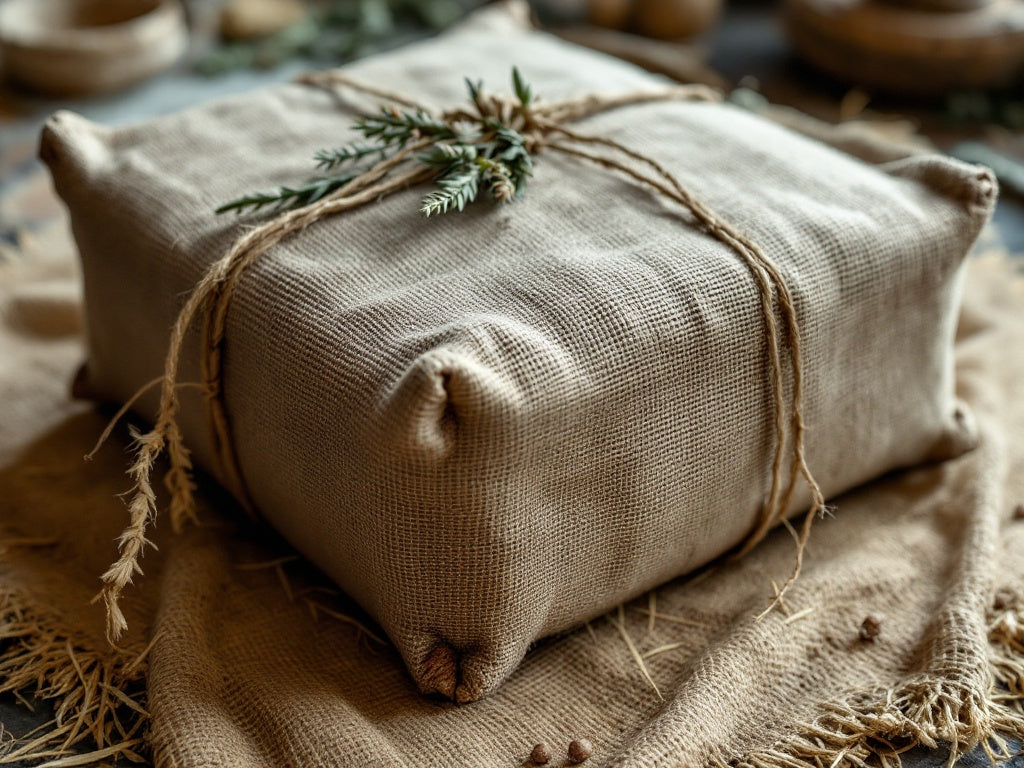
Carefully Wrapped for the Journey Ahead
✨ From Our Workshop to Every Corner of Midgard
Just as each stitch is placed with purpose and care, we prepare your garment for its journey with equal attention to detail. Every piece is lovingly folded and wrapped in craft paper or wrapping paper, secured with twine, and adorned with flax or evergreen sprigs - as if preparing a special gift for someone dear. This careful presentation ensures your handcrafted treasure not only arrives safely but also provides you with the joy of unwrapping something truly special, whether it's a gift to yourself or someone you cherish.
At MIMIRS SAUM, we believe receiving your garment should be as delightful as wearing it. We've woven together a tapestry of shipping options just for you!
Nórðvegr (Norway)
Where Fjords Guide Our Path
Let your new attire sail swiftly across valleys and mountains!
• Package up to 10 kg: 73.00 NOK
• Package over 10 kg: 135.00 NOK
✨ 3-5 business days
Across the Known Lands
From Miklagarðr to Jórvík
From Hedeby to the lands of the Franks, our garments travel far and wide!
• Package up to 2 kg: 250.00 NOK
• Package up to 5 kg: 416.00 NOK
• Package up to 10 kg: 546.00 NOK
✨ 5-7 business days
To Distant Shores
From Serkland to Vinland
Our creations find their way to the far corners of the world!
• Package up to 1 kg: 348.00 NOK
• Package up to 5 kg: 596.00 NOK
• Package up to 10 kg: 906.00 NOK
✨ 10-21 business days
ADDITIONAL INFORMATION & POLICIES
From Our Workshop to Your Door
Like the craftspeople and merchants who traveled the trade routes of the Viking Age, we take care in how your garment reaches you. Here's what you need to know about shipping, customs, and our promises to you.
Swift as Odin's Ravens
Need your garment faster? Express shipping is available upon request. Contact us at contact@mimirs-saum.com to arrange expedited delivery.
A Gift from Valhalla
Orders over 10,000 NOK receive free worldwide shipping—no matter where you are.
Tracking Your Treasure
Every order includes a tracking number sent to your email. Track your garment's journey from our workshop to your door.
Tribute at the Borders
International orders may be subject to customs fees and import duties:
- Customs fees vary by country
- You are responsible for any duties or taxes
- Your package may be held for customs inspection
- We declare accurate values on all customs forms
Questions about your country's import policies? Contact your local customs office before ordering.
The Merchant's Promise
We stand behind our work. Returns accepted within 30 days if your garment is:
- Unworn and unwashed
- With original tags attached
- Unaltered (no modifications)
- In clean, original condition
To start a return, email contact@mimirs-saum.com with your order number.
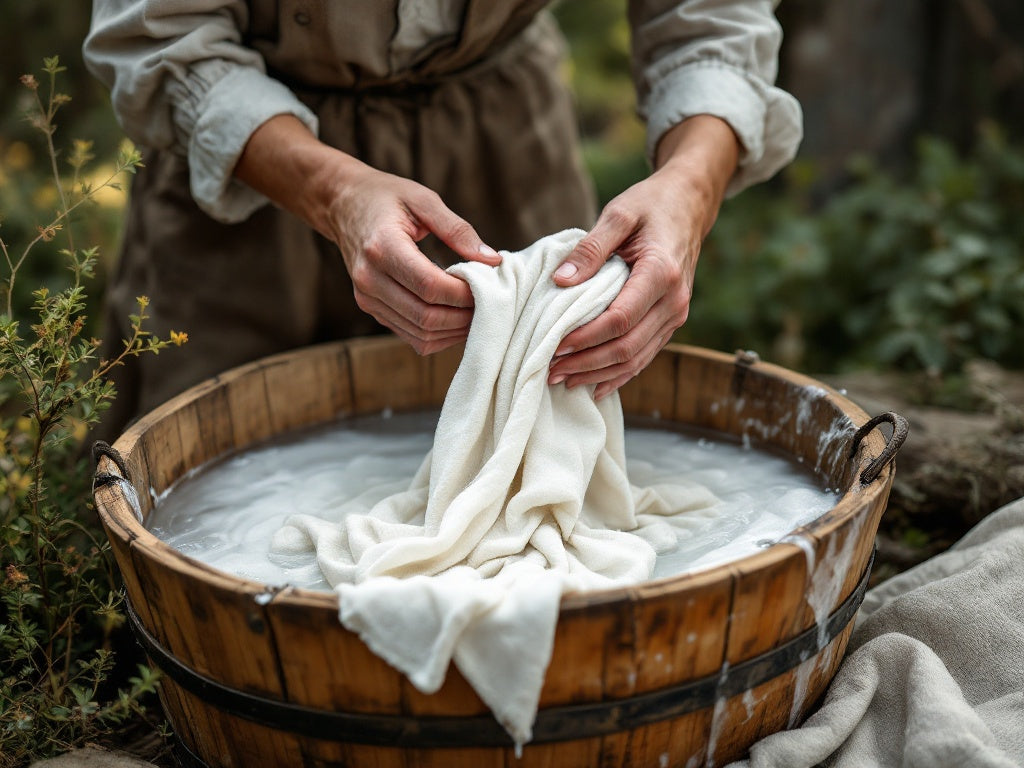
✨ Ancient Wisdom for Natural Fibers
taking care FOR YOUR Hand-sewn GARMENTS
Like the skilled hands that once cared for precious textiles in Viking settlements, your garment deserves mindful treatment to maintain its beauty through time. Natural fibers respond well to gentle care, rewarding you with years of wear and increasing character with each proper washing.
Washing
• Use cool or lukewarm water for linen and plant-dyed fabrics
• Tepid water for wool to prevent felting
• Hand wash gently, avoiding agitation
• Choose mild, natural soaps suitable for each fiber
• Avoid modern detergents and bleach
• Rinse thoroughly in clean water
• For wool, maintain consistent water temperature to prevent shrinkage
Drying
• Never wring or twist any natural fibers
• Roll in a clean towel to remove excess water
• Lay flat to dry away from direct sunlight
• Shape wool garments while damp
• Allow all pieces to dry completely before storing
• Plant-dyed fabrics should dry in shade to preserve colors
Storage
• Store folded in a cool, dry place
• Keep all natural fibers away from direct sunlight
• Allow fabrics to breathe naturally
• Avoid plastic containers that can trap moisture
• For wool, consider cedar or lavender for natural protection
• Iron linen while slightly damp if needed
• Never iron wool - steam only if necessary
Special Care
• Spot clean when possible
• Address stains promptly with fiber-appropriate methods
• Air between wears to maintain freshness
• Handle with clean hands
• Store away from harsh elements
• For plant-dyed items, avoid prolonged sun exposure
WHO WEARS OUR GARMENTS
✨ FOR THOSE WHO VALUE HISTORICAL ACCURACY ✨
